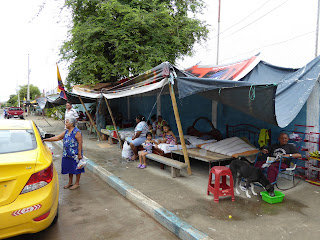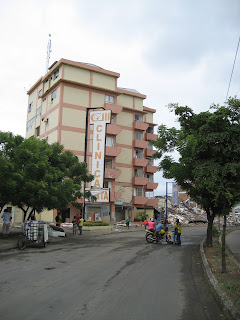This past Thursday, April 28th, was our first visit to one of the towns heavily affected by the April 16th earthquake: Manta. Manta, along with Pedernales and Portoviejo, was one of the most populous cities affected by the quake. (I am not taking away from the destruction that has ruined many of the smaller towns, but these are the cities that are making international news.)
Manta is a city of about 225,000 residents (the exact number was hard to obtain), and is located in the northern section of Manabi province (along with Pedernales and Portoviejo). To provide perspective, here are the locations of the points that I'll be discussing:
Our town, Puerto Lopez, is on the coast at the very south of the map above. Manta is about 120 km north of us, and Portoviejo is a 15 minute drive east of there. The earthquake was centered just off the coast of Muisne at the very top of the map, and Pedernales is about 30 minutes south of there.
Visiting any of the areas between Muisne and Manta is discouraged. Although police restrictions have been relaxed in most areas, travelers and casual visitors (especially gawkers) are strongly discouraged. As it turns out, though, our group had a couple of items that required a visit. I needed to visit one of the labs that (in Manabi) only exists on the coast, and Diane's mechanic had finished repairs on her car that she had dropped off prior to the earthquake.
Our group consists of Emily and I, our friends Paul and Susan from who we rent and our good friend Diane who owns a business here in town. Since Susan had other commitments that day, our traveling party consisted of Paul, Diane, Emily and myself.
From the information that we had been receiving, it seemed that food and water were available to most of the people displaced from their homes. The most pressing need was solid shelters, and there are a number of groups that are in the process of providing those. For our trip, we wanted to do something that would brighten the day for the number of children that were currently living on the street. The decision was to create a "gift bag" that we could give to the children that we met along the way.
After a day of shopping, Susan and Emily set about baking and sorting items for the gift bags. Each one contained juice boxes and some candy treats:
The next day, we set out for Manta. After completing our errands, we looked for children where we could deliver the bags. We didn't have to go far. Just down the street from Diane's mechanic, we came upon two "tent cities" where the displaced residents had moved:
These are the two that we visited. The first covers the sidewalk along the roadway and the second is up on a dirt berm next to a soon-to-be landfill. Although they are (mostly) dry, they are truly depressing places. The blue barrels are the primary source of water, there are no bathrooms and there is no electricity.
The individual tents, covered with plastic tarps and held up by whatever wood or bamboo is available, contain all of the possessions that these people now own:
We parked on the street in front of the lower tent city, and Diane got out of the car with a few gift bags to give away:
It wasn't long before the word spread and the other kids came running:
Once they realized the ultimate source of the gift bags, however, I was up to my ears in outstretched hands!
Hey! How did he get three of 'em?!?
Eventually, we ran out of the full bags. Emily had prepared a couple of smaller bags of single pieces of candy and lollipops that she was able to hand out on an individual basis (especially helpful when I had to inform them that I had no more bags to give):
As we were leaving the tent cities, we were able to get one group photo from the upper group and some big smiles from the street-side people:
Many thanks to Paul for taking all of the pictures!
While we were grateful to be able to share with the children here, our smiles wouldn't last for long. With our main objectives completed, we wanted to look around Manta and see the extent of the damage. We had all seen pictures (like I'll being showing here), but it's much different in person. The sounds, smells and dust are only matched by the looks of desperation on some of the people that we met.
First, a couple of the medical facilities. The first picture here is of the hospital next to where I had my lab work done:
These are pictures of Clinica Manta and the private practice of a general practitioner that I had visited just two months earlier. Fortunately, the structure of the hospital was solid enough that people were able to get out; I'm not so sure about the private clinics next door:
Some of the workers were able to salvage one of the hospital beds. The CT scanner, however, was a total loss:
Even the IESS (public) hospital, which should have been one of the strongest buildings in town, will require either a serious makeover or a total tear down:
The neighborhood of Tarqui was the hardest hit in town and is still classified as a Zone Zero (no unauthorized personnel allowed, period). The market area that had been located near Tarqui had to relocate a few blocks down the road:
I'm sorry for the quality of these last two pictures; they were taken from a moving vehicle. Note, however, the depth of debris in the first of these two: easily eight to ten meters deep. All of the workers inside Zone Zero appeared to be wearing hazmat suits.
Here are just a few more pictures of other buildings that will require complete tear down and reconstruction:
Like I said, there weren't too many smiles to be had from myself, Emily or Diane:
Hopefully, the smiles will return soon. This weekend, we're building another 200 bags of treats for the tent city children and we'll be delivering them on Monday. We're doing what we can!



































